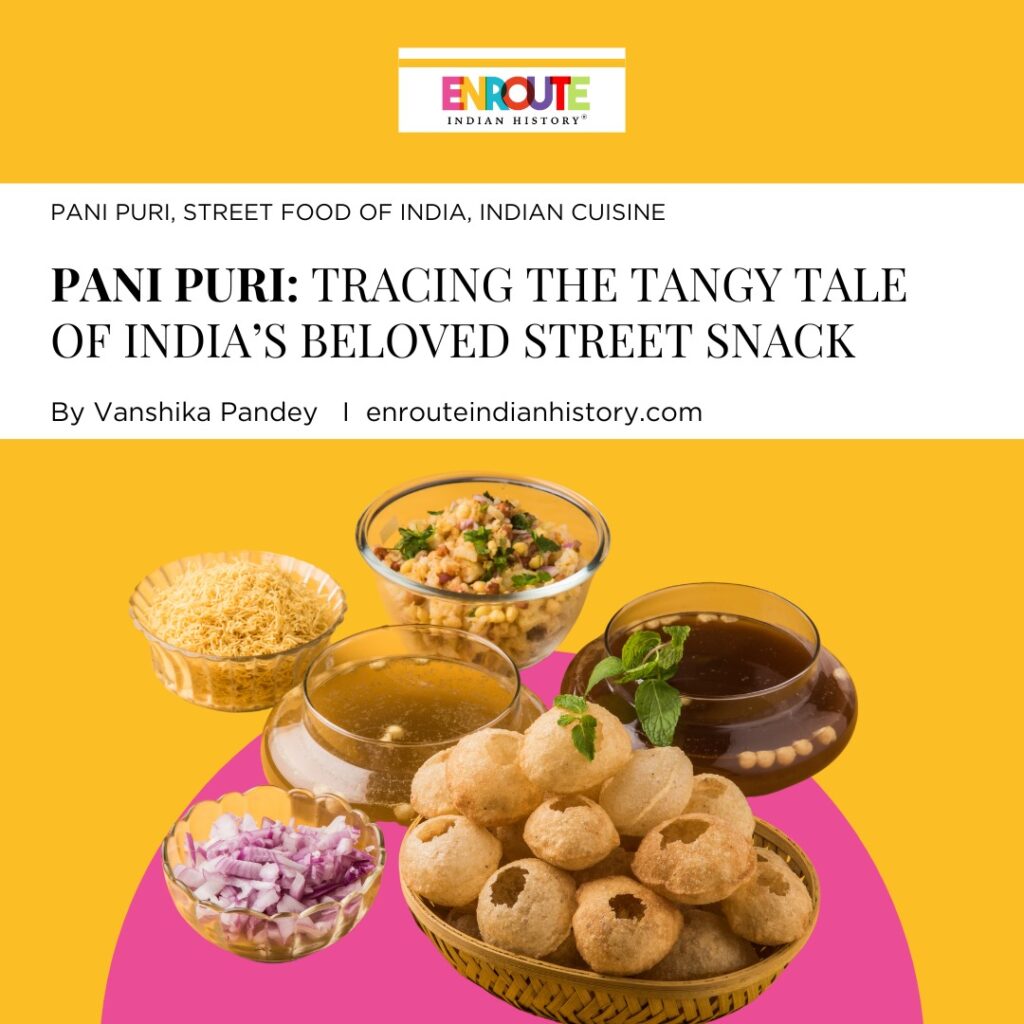
Pani Puri or Gol Gappe would take the top spot as the most popular and iconic street food. Crispy, hollow puris either made of semolina (suji) or wheat flour (atta), filled with boiled potato and chickpea filling, topped with spicy and tangy tamarind water can make our taste buds dance like no other. Somehow, the different flavours and textures come together to create something so delicious and addictive that you’ll want to keep having it, it is also amazing how this lip-smacking snack is a balanced meal on its own, with carbs from the puri and potatoes and protein from chickpeas that can keep you full for a long.

Image source- istock
Pani puri is more than just a snack, it’s a cultural phenomenon in India. For many, it’s a part of everyday life, an excuse to bond with cousins or neighbours or school or tuition friends. From the streets of Mumbai to the street corners of Kolkata to the lanes of Delhi, Pani puri stalls can be found everywhere, serving this delicious and refreshing snack to hungry customers and providing employment to countless.
While diving into the history of Pani Puri, we mainly encounter two origin stories:-
Pani Puri, believed to have originated in ancient India by the name of Phulki, was inspired by the culinary advancements of the Magadhan empire, particularly in the region of west Bihar. The legend of Magadh’s culinary prowess fueled stories of Pani Puri’s creation during this era. While historians like Megasthenes have documented the food culture of Magadh, the specific name of the inventor of Pani Puri remains unknown.
The other myth surrounding the origin of this popular street snack dates back to the Dvapara Yuga era, legends have it that upon Draupadi’s return home after her marriage, her mother-in-law, Kunti, devised a test to assess her ability to manage with limited resources. Kunti provided Draupadi with some leftover aloo sabzi and a small amount of wheat dough, instructing her to prepare a meal to satisfy the hunger of her five sons. Draupadi ingeniously combined these ingredients to create Pani Puri, a dish that Kunti blessed with immortality, and we all know how that blessing turned out!
However, it is important to note that these origins do not have a solid historical backing and the fact that potatoes, a main ingredient in the dish, are not native to South Asia and were brought by the Portuguese in the 16th century, so Pani Puri in its current form cannot be older than 400 years, although one can’t deny the fact that the above-mentioned dishes could be a precursor of the Pani puri we know today.
Famous humorist Zac O’ Yeah presents an alternate account of the origins of panipuri in his book “Digesting India.” According to this version, during Mughal era, the Yamuna River was feared for its association with diseases. In response, the royal physician at the imperial court in Delhi supposedly devised a diet rich in specific spices to counteract the harmful effects of the river water. This blend of spices and condiments, believed to have disinfectant properties was put in a dish similar to Pani Puri ( or a precursor of it), that spice blend is said to have evolved into the classic chaat masala that is popular today. Later, Pani Puri became a staple in the Mughal kitchen, and it later spread to the streets for masses to enjoy.
Kurush Dalal, a respected archaeologist and culinary anthropologist, shares a similar perspective. During a discussion on the roots, evolution, and diversity of Pani Puri, he articulates the essence of the puri as “a vessel” with precision and eloquence. He elaborates that as the puri transitioned from the Raj kachori, its filling was determined by the creativity of the maker and the preferences of the consumer.
According to renowned academic and food historian Pushpesh Pant, attempting to pinpoint the exact time and place of Pani Puri’s inception is a flawed pursuit. In an interview delving into the history of Indian cuisine, Pant suggested that it might be futile to try to identify a singular origin for such versatile delicacy, as every aspect of it is constantly changing.
Few cuisines are as famous for street food as India. From Mumbai’s Vada Pav to Delhi’s Chole Bhature to Gujarat’s Dabeli, each state has its own delicacies waiting to be explored. But one street food, in particular, overwhelms the others. Gol Gappe, Pani Puri, Puchka, Pani ke Batashe, Gupchup, Phulki, names might differ but this beloved street snack with regional variations, is found all over the nation, as well as in Pakistan, Nepal, Bhutan, and Bangladesh.
In several North Indian regions such as Punjab, Jammu & Kashmir, and New Delhi, the popular Indian snack is referred to as Golgappe or Golgappa. Typically, the puri used for Golgappas is crafted from semolina (suji), although some vendors offer versions made with whole wheat flour (atta). These crispy shells are filled with boiled chickpeas, boiled potatoes, and a delightful sweet tamarind sauce known as saunth chutney. Subsequently, the Golgappas are immersed in a large container filled with spicy and minty water, ensuring they are thoroughly soaked. Served brimming in a dona, which is a disposable Indian bowl commonly used for serving chaats, they are ready to be relished.
In the states of East India such as West Bengal, the snack is famously known as Puchka. Puchka differs slightly from its counterparts, as it is made with a filling comprising boiled gram, mashed potatoes, and green chillies, often topped with a squeeze of lemon for added zest, sometimes, even bananas.The accompanying chutney adds a tangy flavor, while the Imli (tamarind) water brings the heat with its spicy kick. Puchka puris are typically larger than the usual ones and are made from wheat flour.
Pani Puri as called in Gujarat, Madhya Pradesh, Karnataka, Maharashtra, Tamil Nadu, and even in Nepal is a fried, hollow, and round puri filled with a delectable blend of sweet and spicy water, accompanied by tangy tamarind chutney, potato, chickpeas, and chaat masala. In Gujarat, it’s common to find finely chopped potato slices combined with sweet chutney, while Mumbai’s version often features ragda (mashed white beans) as a filling, complemented by the sweet tang of tamarind chutney.
Famous in regions spanning Uttar Pradesh, including Kanpur and Lucknow, as well as Rajasthan, the Paani ke Bataashe offer a distinctive culinary experience. These bataashe, or pooris, are typically stuffed with white peas and boiled potatoes, but what sets them apart is the unique blend of spices infused into the water. Notably, certain locales are renowned for offering a variety of five different types of flavoured water specifically crafted for these Bataashe, adding an extra layer of diversity to this cherished street food.
This unique variation of Golgappa, known by the quirky name “Gup chup,” holds a special place in the street food scenes of Hyderabad and Odisha. Its distinctive name originates from the satisfying popping sound it makes when bitten into. The shell of Gup chup is crafted from a blend of whole wheat flour, refined flour, and semolina, lending it a delightful texture. While the filling may vary between white peas or chickpeas, potatoes and flavoured water remain consistent elements, ensuring a familiar taste with every bite. These are often served as a warm dish in these regions.
In Madhya Pradesh and certain areas of Uttar Pradesh, Golgappas take on the name “Phulkis”. Essentially, Phulkis are identical to Golgappas, differing only in name. Across various regions, Golgappas are sometimes served with a unique twist as “dahi ke batashe” or “dahi puri,” featuring a filling of curd and chutney, offering an equally delightful taste experience. These delectable treats are often garnished with crunchy sev, fresh coriander leaves, and juicy pomegranate seeds, adding layers of texture and flavor.
Pani Puri’s journey from humble origins to global recognition parallels the broader phenomenon of culinary globalization and the commodification of cultural heritage. One aspect of the appropriation of Pani Puri lies in its adaptation to fit the demands of mass production and commercialization. Traditional recipes may undergo modifications to streamline production processes and extend shelf life, potentially altering the authentic taste and nutritional value of the dish. This transformation caters to consumer preferences for convenience and accessibility, often at the expense of cultural authenticity. Furthermore, the gentrification of street food culture can contribute to the commodification of Pani Puri, transforming it from a communal dining experience to a trendy, upscale offering targeted at affluent consumers.
References
- O’Yeah, Zac, “Digesting India”
- Pant, Pushpesh, “The Indian Vegetarian Cookbook”
- Banerji, Chitrita, “Eating India”
- Slurrp Editorial,(2022, Dec 8). Why Is Golgappa So Popular In India? https://www.slurrp.com/article/why-is-golgappa-so-popular-in-india-1670480623607
- May 15, 2024
- 6 Min Read

























